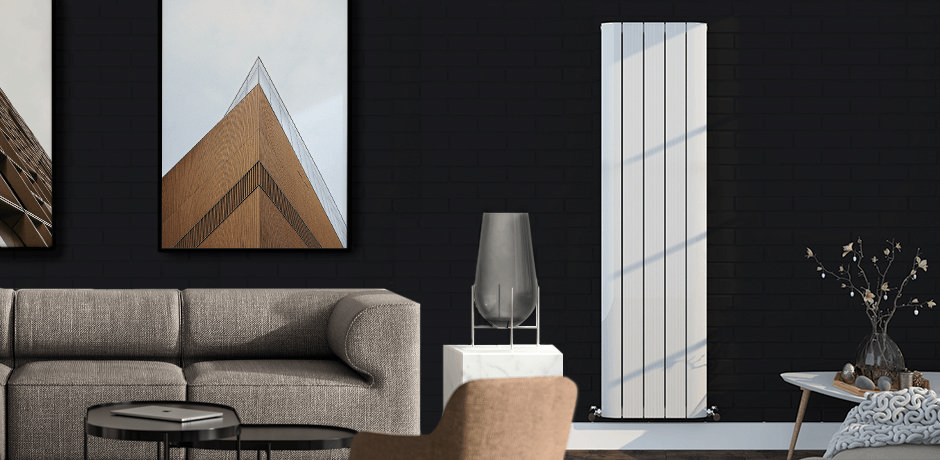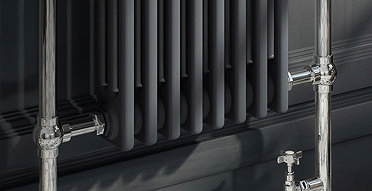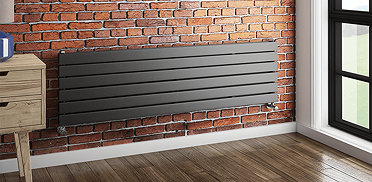OUR WINTER SALE ENDS SOON!
*Boxing Day deals coming soon. Free delivery on orders over £499
Are Vertical Radiators Efficient?
Are Vertical Radiators Efficient?
Vertical radiators are a modern and stylish addition to your home. But are vertical radiators efficient, and how do they differ from typical horizontal radiators?

Vertical radiators have become a popular choice in home décor as of late. They add a stylish vibe to minimalist spaces, helping to incorporate unique character in tall and open rooms. They can also function as a great neutraliser in those busy communal spaces. With that being said, are vertical radiators efficient, and how do they compare to horizontal radiators?
How efficient are vertical radiators in heating a room?
Just like horizontal radiators, the efficiency of vertical radiators is calculated by BTU. In essence, the higher the BTU of a radiator, the higher the heat output. So when it comes to vertical radiators, quality is not compromised by style. They’re equally as efficient as horizontal radiators, and their capacity for heat output is better measured by BTU than anything else.
In addition, vertical radiators are available in electric variations and can be plumbed into central heating just like horizontal ones.

What is the difference between vertical and horizontal radiators?
To break it down to the basics, vertical radiators are tall, slim radiators. They tend to have fewer pipes than vertical radiators, although there are a variety of designs to choose from. Not to mention, having fewer pipes is made up by the length of the pipes themselves in a vertical radiator. Vertical radiators tend to range from 300mm to 800mm in width and 600mmto 1600mm in height.
Horizontal radiators are much shorter and wider, stretching from wall to wall rather than floor to ceiling. Both are available in column radiator and cast iron radiator variations.
Due to their stylish design, vertical radiators tend to be part of your décor rather than simply a practical choice for your space. Their tall structure makes them more prominent in the room than horizontal radiators, which often sit at furniture height. This means that they can be an intentional asset to your home design. As a result, you might be more likely to find vertical radiators in living rooms and kitchens than bathrooms and hallways. But they can be incorporated into these areas of your home too!

Another result of their design, perhaps one of their only cons, is that if you wish to transition from a horizontal radiator to a vertical one, this may be a tad tricky. As they are such different shapes, the pipework is unlikely to match up.
Horizontal radiators might be better suited to open spaces with wide walls in comparison to vertical radiators. Due to their low and expansive nature, you can have a horizontal radiator stretch pretty much as far as you want, which might help to make a wide wall seem a little less bare.
So it would seem that, for the most part, these differences are more a matter of personal style than anything else!
Popular vertical radiator designs
Vertical Flat Panel Radiator

For the most modern vertical radiator look, flat panel vertical radiator designs are certainly one of the most popular. Their sleek finish makes them ideal for fitting in with minimalist décor, but they can also suit more busy spaces where you might want a more subtle look. When it comes to this style, anthracite grey gives it ultimate suave and sophisticated edge.
Vertical Column Radiator

Column radiators are a popular horizontal radiator design because of their efficient heat output, durable build and versatility. So of course, this same build also functions great as a vertical radiator too!
Cast Iron Style

While vertical radiators are more typically associated with a modern aesthetic, you can still pull off a traditional look if that is more your style. Cast iron radiators are the perfect way to incorporate a modern radiator with traditional features.
So in answer to the question “Are vertical radiators efficient?” the short answer is: Yes! They’re equally as efficient as horizontal radiators in terms of their heat output. In terms of practicality, this comes down to the layout of your home and just how trendy you want to be.

Trinity
Trinity is one of our expert bloggers in bathroom design and DIYs. Read her blog posts for the latest coverage of style trends and easy-to-follow guides.


